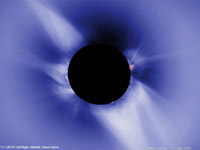On Wednesday, 29 March 2006, a total eclipse of the Sun will be visible in Egypt!
Total eclipses of the Sun are among nature's most spectacular phenomena, and are epic celestial showpieces that dazzle amateur and professional astronomers alike.
The total eclipse will be visible along the totality path, where the umbra of the lunar shadow falls on our planet. This path will be very long, extending for thousands of kilometres; but it will be also very narrow; less than 180 km wide! The eclipse will be partial in the much broader region swept by the lunar penumbra. In Alexandria, the eclipse will be partial and will start about a half hour before midday, lasting about two- and a half hours.
|
|
Map 1: The eclipse path across the Earth |
Animation: The lunar shadow traverses the surface of Earth |
Solar eclipses have been observed throughout history, and had a profound impact on early cultures. Chinese astrologers recorded a solar eclipse over 4,000 years ago; and recent research has demonstrated that solar eclipses had been depicted in the fascinating mythology of ancient Egypt.
Total eclipses of the Sun occur when the Moon passes between the Sun and the Earth, dropping its shadow upon the Earth's surface. Every year, 2-5 solar eclipses take place somewhere on our planet; but for a given location, e.g., Alexandria, several centuries may elapse between two successive total solar eclipses!
A total solar eclipse is lifetime experience in which the Moon blocks the Sun completely; the air temperature falls; the sky darkens, and even stars and planets appear in daytime; animals get confused: in the darkness of totality bats fly and birds sleep!
Totality is also a special, brief opportunity to glimpse the charming solar corona, the outermost layer of the Sun's atmosphere which appears as a pale, diffuse glow surrounding the eclipsed Sun. The solar corona cannot be seen in broad daylight, as it is much fainter than the brilliance of the Sun's disc!
However, in normal conditions the mysterious corona can be studied in detail using sophisticated instruments that artificially eclipse the Sun (by means of an occulting disc) and enable the corona to be viewed.
Figure 1. The solar corona photographed in a total solar eclipse

|
We can enjoy the view of the corona during total solar eclipses due to a cosmic coincidence! The Sun's true size is far larger than that of the Moon: the diameter of the Sun is 400 times larger than that of the Moon, but the Sun is also 400 times more distant! This wonderful coincidence makes the two brightest celestial objects appear with almost the same size! |
This is also a unique coincidence in our Solar System! The apparent sizes of the moons of the other planets (as seen in the skies of the planets) are obviously smaller or bigger than the Sun. So, when any of those moons eclipse the Sun, the solar corona is invisible.
Fortunately, in the space era, solar eclipses by the two tiny moons of Mars have been imaged from the surface of the Red Planet by NASA's twin robotic, six-wheeled Mars Exploration Rovers. The picture below shows two Martian solar eclipses imaged by the Mars rover Opportunity.. |
|
|
Figure 2. Solar Eclipses on Mars
Image credit: NASA-JPL |
Figure 3. The Mars Exploration Rover, an artist's impression
Image credit: NASA-JPL |
If the orbit of the Moon and the Earth's orbit around the Sun were in the same plane, there would be a solar eclipse every lunar month at New Moon, but actually the lunar orbit is inclined at a little over 5 degrees with respect to the Earth's orbit. This is what makes solar eclipses less frequent.
As the orbit of the Moon is slightly elliptical, the Earth-Moon distance varies considerably, and the apparent size of the Moon is smaller than average when the Moon is in the farthest parts of its orbit. Thus, in some solar eclipses the Moon does not cover the Sun completely, but leaves a dazzling ring of the Sun's disc. In this case we have an annular solar eclipse.
Interestingly, very precise measurements, and elaborate astronomical computations have showed that due to the tidal interaction between the Moon and the Earth, the Moon is receding away from us! Every year, the Moon's distance increases 4 cm; hence, the apparent size of the Moon is very slowly shrinking! This means that eventually the Sun will appear larger in the sky than the Moon, and, in the far future, in a billion years time, solar eclipses will be only partial or annular!
So, do not miss the chance of viewing the 29 March 2006 total solar eclipse! Come on and join our eclipse expedition! |
